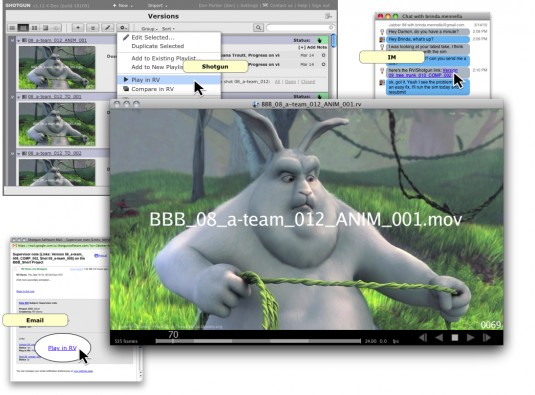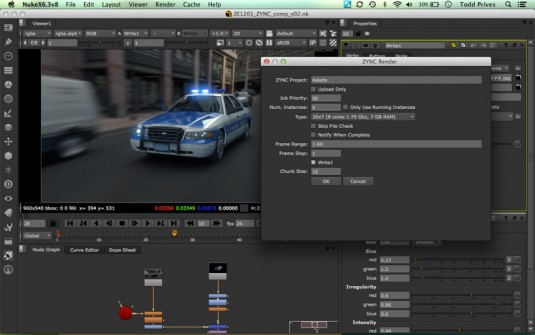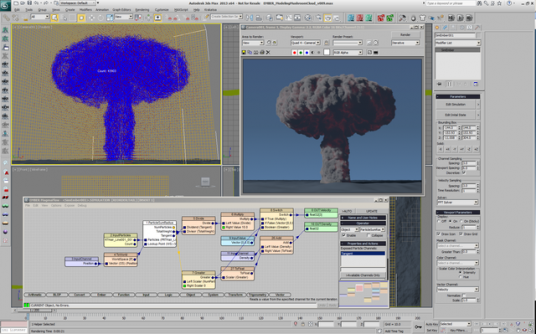Shotgun, Tweak, Zync Render, Fabric Engine, and Thinkbox sell multimedia solutions that work with each other.
By Kathleen Maher
The Shotgun booth at Siggraph keeps getting bigger. This year the company included demonstrations from several companies it works with. Shotgun Software builds pipeline tools, which on the face of it doesn’t sound very sexy for graphics and multimedia, but pipeline tools are becoming another important tool in the battle to make content creation work efficient and profitable.
As the past year has dramatically illustrated, there’s not much room for leakage in the production world, and as companies increasingly globalize and hand off content locally and around the globe, the potential for problems increases. It’s an opportunity for cloud-based workflows using either public or private clouds. One part of Shotgun’s strategy is to encourage the use of open platforms for more transparent data transfer and collaboration. At Siggraph the company unveiled its Shotgun 5.1 release, which focuses heavily on ease-of-use features including a redesigned interface, easier browsing, and the ability to create and edit playlists in Shotgun’s Screening Room review tool.

Tweak
Tweak Software builds a tool to enable content viewing and playback. The company has developed its software through its work at ILM, MPC, Weta Digital, and others. Images and sequences are displayed accurately and in context. And also, through Tweak’s collaboration with Shotgun and its own programmability, content can be integrated into workflows to share content across sites or locally. Tweak’s accomplishments are pretty impressive. The company has developed its own RVX Core, an image-processing engine that can handle all commonly used formats, and it can bring them into a common LUT (look-up table) space using GLSL shaders. So, for example, a specific LUT can be defined for a show, and all content brought together and screened with a consistent look. Or, Tweak quotes Daniel Fagnou from MPC who says, “We developed a custom GLSL shader to display any out-of-gamut pixels when converting images between different color spaces.”
Tweak says RVX Core features fast I/O, resolution-independent image handling, hardware-accelerated floating-point image processing, and advanced color management. Tweak’s co-founder Seth Rosenthal describes RVX Core as a building block. RV 4.0 is the first product based on the new architecture, but he says all their existing tools including RV, RV-SDI, and RVIO will standardize. In addition, he says, it will allow Tweak to build a new generation of tools for artists, and the company plans to open up RVX Core so users can also build their own apps.
Tweak’s brain trust was fostered at ILM. The company was founded by Rosenthal and Jim Hourihan. Hourihan is a pioneer of modern digital effects including the Dynamation particle generator that came to define Wavefront in the 1990s. He also helped develop Maya’s scripting language MEL, and he has worked at ILM. He has stacked up credits for the great special effects extravaganzas including Lord of the Rings: The Return of the King, and Star Wars V and VI, Episode 1, The Day After Tomorrow, and more. Rosenthal comes from ILM, where he oversaw teams creating new technology. Alan Trombla, director of product development, was also at ILM, as well as Lucasfilm Animation and Digital Domain.
Zync
Zync is a young company that has emerged from the conflagration of VFX companies. The founders, Brian Dewes, Sean Devereaux, and Todd Prives, come from Brickyard Films, Digital Domain, ILM, and Hydraulx. Zync was developed as an in-house render tool at Zero VFX. It mimics a local system with a small client-based app, but is capable of scaling and provides on-demand rendering. The system offers cloud-based rendering and storage and uses standard bandwidth. Users are changed by the hour. Plug-ins are available for Nuke and Maya. The Maya tool works with Amazon EC2 and lets users fire up as many instances as they need and drop them when they don’t need them. Writer Paul Hellard has written up Zync at CG Society. He notes that Zync lets small companies look like big companies without having to go out and buy large render farms. He says the company has wins with large houses and can claim to have worked on major products (without mentioning names), but they also have a loyal base of small companies. Hellard singles out Atomic Fiction as being able to do work alongside larger companies.

Zync is developed with an open API, which has been used to integrate with Shotgun. When a job is done rendering, it’s updated in Shotgun. The open API also allows Zync to be integrated into other pipelines as well.
An overview of Zync, as posted on YouTube. (Source: ZyncRender)
Thinkbox
Thinkbox is yet another company in the loose coalition built around Shotgun. Thinkbox has a variety of tools developed in the context of movie production. They were showcasing their render management tool Deadline 6.1. Chris Bond, the company’s founder, says Deadline 6.1 lets companies take advantage of local, remote, public, and private clouds as if it all were a single render farm. In addition, Deadline can be scripted to conform to specific workflows. For instance, dependencies can be set up so that a job doesn’t render until all assets are ready to go.
The latest version of Deadline adds support for distributed bucket rendering in 3ds Max and Maya with Chaos Group’s V-Ray. An interface can notify which nodes are running and which nodes are available. In addition, the new software enables multi-region rendering for 3ds Max to replace the single frame tile rendering. Users can define arbitrary regions for rendering. Maya users will get tile rendering support for Solid Angle’s Arnold renderer. Thinkbox’s commitment to open APIs means it can be easily integrated into the Shotgun workflow or that of other workflow tools.

Fabric Engine
Fabric Engine made its debut at Siggraph this year, where it arrived as a development tool for companies in the film and TV industries. Most of the principals have come out of Softimage and were involved in the development of that product’s ICE development engine. The ex-Softimage people include Paul Doyle (CEO, founder), Philip Taylor (CTO, founder), Helge Mathee (R&D, engineer), and Jerome Couture-Gagnon (core engineer). The third founder, chief architect Peter Zion, specializes in low-level device drivers and has worked in iPhone development and was a driver developer at Broadcom. Andrew MacPherson, core engineer, is experienced in Linux server software and low-level Linux applications.
Fabric Engine is primarily a creation platform and includes tools such as Splice, which enables the creation of C++ nodes that are faster than scripts created with Python of MEL, but easier to use. The company has also created its own modules including Stage and Horde. Stage is a scene assembly, lighting, and shader authoring system that can support any renderer such as Chaos Group’s Vray or Pixar’s Renderman via an API, and they integrated support for Solid Angle’s Arnold renderer. Horde is a real-time crowd system that features an easy-to-use painting interface to control large numbers of agents. At Siggraph, former Autodesk M&E chief Marc Petit revealed his role as the company’s chairman of the board. He has been instrumental in getting funding for Fabric Engine.

Our take
That’s a lot of stuff, isn’t it? The reason I talked about all these companies together was to highlight the emergence of new axes of influence. Based on their use of open standards, these companies are able to work with studios to develop portable workflows and tools that can be built to work with what the studio TDs (technical directors) and artists want to work. Another axis is The Foundry, which is happy to work within the framework of open APIs and is trusted by the studios such as Sony, Weta, and Digital Domain to take technology and turn it into products including Nuke, which came from Digital Domain, the Katana look development tool originally developed by Sony, and the Mari paint tool, which came from Weta.
When he was at Autodesk heading M&E, Petit talked about the studios’ willingness to use off-the-shelf tools that came with crazy-high VFX budgets. Now, there’s a new phase that’s emerging, and that’s the ability to be nimble and to enable fast ad-hoc development—to be efficient and creative and original and to keep what works and improve on the fly.





